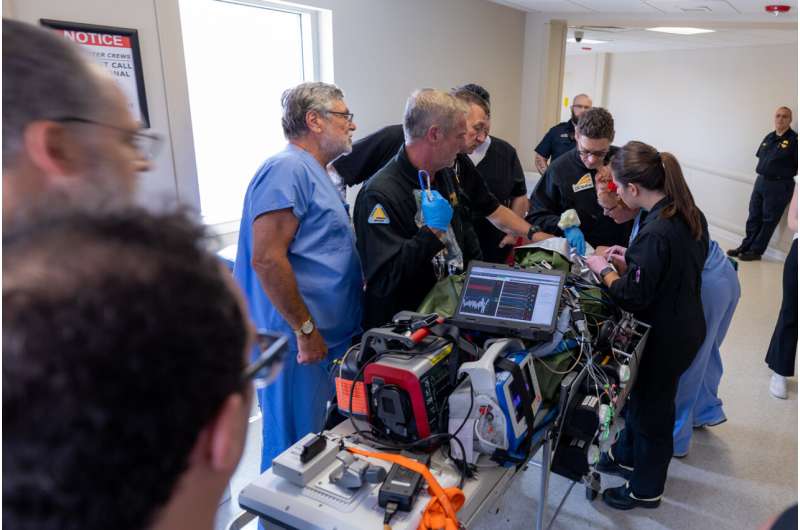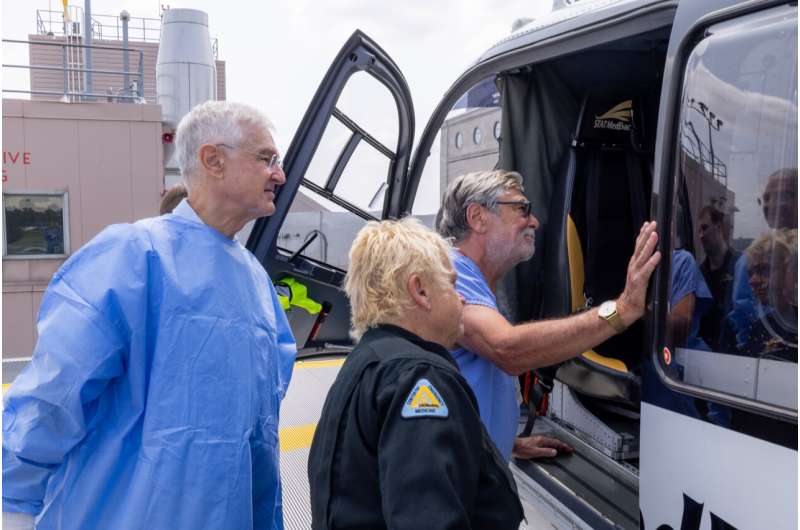This article has been reviewed according to Science X's editorial process and policies. Editors have highlighted the following attributes while ensuring the content's credibility:
fact-checked
trusted source
proofread
Autonomous medical intervention extends 'golden hour' for traumatic injuries with emergency air transport

For the first time, a closed loop, autonomous intervention nearly quadrupled the "golden hour" during which surgeons could save the life of a large animal with internal traumatic bleeding while in emergency ground and air transport.
This breakthrough in trauma care, announced in Intensive Care Medicine Experimental by physician-scientists at the University of Pittsburgh School of Medicine, has enormous potential for saving the lives of traumatically injured members of the military harmed in remote battlefields or civilians injured in mass casualty events or rural locations far from advanced medical care.
"Under normal conditions, if we can get somebody with severe trauma to the hospital within an hour, there's a good chance that we can save them," said the project's scientific lead Michael R. Pinsky, M.D., professor of critical care medicine, bioengineering and clinical and translational medicine at Pitt.
"For the first time in the history of medicine, we took an animal in a critical state onto a helicopter and autonomously brought it back healthier than when it was placed in emergency transport hours earlier. The implications this has for treating people in the field with trauma are phenomenal."
The multidisciplinary Pitt team, assisted by computer scientists from Carnegie Mellon University, tested a key component of the Trauma Care in a Rucksack (TRACIR) system, designed to fit inside a backpack that could be delivered by drone to remote locations.
The minimally invasive, closed loop algorithm, called Resuscitation based on Functional Hemodynamic Monitoring (ReFit), autonomously gave intravenous fluids, blood and drugs to maintain vital functions in pigs with a traumatic lethal liver injury for three to five hours without human intervention, while they were transported by ground ambulance and helicopter and finally returned to the laboratory surgical suite as a demonstration project.
On different days, a total of four fully anesthetized pigs—whose anatomy and response to traumatic injury closely resembles that of humans—underwent surgical liver laceration in a laboratory surgical suite under approved animal research guidelines. They were allowed to hemorrhage for 30 minutes before being resuscitated with the ReFit computer algorithm system, which is about the size of a microwave.
Once the autonomous resuscitation device was turned on, the pigs received no medical intervention from a human beyond monitoring by an emergency medicine doctor to ensure they remained fully anesthetized and in no discomfort.

Two of the pigs, connected to ReFit, were placed on a stretcher and moved by emergency medical technicians to a hospital helipad where a medical helicopter flew them around Western Pennsylvania for several hours to mimic an emergency rescue from a remote location. The other two were transported first by ground ambulance to the Allegheny County Airport where they were then loaded onto a medical helicopter and flown back to the hospital helipad over similarly prolonged flight paths to simulate long distance transport.
Once returned, the research team confirmed that they could resuscitate the anesthetized pigs autonomously for several hours without human intervention using only a computer-generated autonomous care algorithm.
"By keeping these animals with a lethal injury alive for up to five hours with a computer driving the resuscitation, you can see how that extends the golden hour," said principal investigator Ronald Poropatich, M.D., director of the Center for Military Medicine Research and professor of medicine at Pitt. "We are excited about the potential to soon apply this technology to saving the lives of people injured in austere environments."
The team's next step is to test transporting ReFit-connected injured animals by unmanned aerial drones to make the process even more effective for rescuing injured people in difficult-to-access locations, such as a mountainside or a military battlefield.
More information: Autonomous Precision Resuscitation during Ground and Air Transport of an animal hemorrhagic shock model, Intensive Care Medicine Experimental (2024).





















